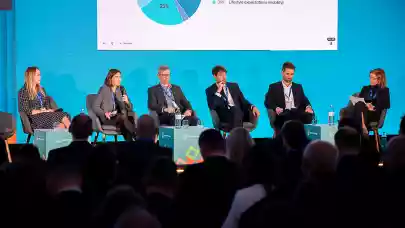
The 2024 results signalled a return to stability in Poland’s real estate market, accompanied by a renewed sense of optimism. Total transaction volume more than doubled compared to 2023, reflecting a strong resurgence in market activity. This positive momentum is expected to continue into 2025, supported by anticipated interest rate cuts, improved liquidity, and the emergence of numerous new opportunities across all real estate segments, says Avison Young.
As of Q1 2025, Poland recorded €686 million in investment transaction volume, representing a 64 per cent year-on-year increase. A 46% rise was observed in market liquidity. The transaction structure was primarily driven by the retail sector, particularly retail parks and non-core offices. As a result, the average transaction size remained relatively modest, with only four deals falling within the €50 - €75 million range. Domestic investors accounted for 17% of the disclosed investment volume, underscoring the stable presence and growing influence of Polish capital in the market.
The industrial investment market gained strong momentum, accounting for 29 per cent of total transaction volume, and additionally recorded a large M&A deal. Office transactions were recorded both in Warsaw and in regional markets, while retail investments were concentrated in retail park assets and shopping centres located in secondary cities. The market also witnessed three living sector transactions closed, alongside a hotel acquisition that marked the entry of a French SCPI into the Polish investment landscape.
Highlights:
- €686 million – total investment volume in Q1 2025
- 35 transactions
- High liquidity with moderate tickets
- GLP to Ares – large industrial M&A
Industrial market – safe bets
Sustained investor interest in Poland’s logistics sector signals continued acceleration in this real estate segment. Amid ongoing geopolitical uncertainty, Poland stands out as a strategic destination for foreign investors pursuing nearshoring strategies, highlighting the sector’s strong long-term growth potential.
In Q1 2025, the industrial sector recorded five completed transactions totalling €202 million, accounting for the largest share, 29 per cent of Poland’s total investment volume during the period. The deals involved large-scale big-box logistics assets located in the Tricity and Warsaw agglomerations, as well as a modern logistics and cold storage facility situated in Warsaw zone I.
Another indication of potential acceleration in this market sector is the number of technical due diligence (TDD) projects carried out by our Technical Advisory team. The majority of these TDDs relate to industrial assets, which serves as a strong signal of upcoming transaction activity in this segment.
Poland’s industrial sector has consistently remained a strong performer, even during challenging times. Therefore, with the anticipated acceleration in the investment market, Avison Young expects a growing number of portfolio deals as well as M&A transactions. One notable transaction has already been finalised, with GLP divesting its assets, including an extensive Polish portfolio, to Ares Management, as part of a global M&A deal.
Highlights:
- €202 million – sector’s volume in Q1 2025
- 5 transactions
- GLP to Ares – large industrial M&A
Retail market - convenience format out of major cities
Poland’s retail sector continues to attract strong investor interest. Following the sale of several large prime shopping centres in 2024, early 2025 has been dominated by convenience-driven assets. As of Q1 2025, the market has recorded 14 retail transactions, with Avison Young acting as advisor in 20 per cent of the completed deals.
The retail investment volume in early 2025 was dominated by retail parks, with a 56 per cent share of the investment volume. This asset class continue to be viewed as a reliable and secure investment option, maintaining its appeal among investors. Key transactions in Q1 2025 included the acquisition of Power Park Olsztyn by BIG Shopping Centres and Comfy Park Bielik in Bielsko-Biała, where Avison Young facilitated the purchase by Newgate Investment. Additionally, a portfolio of two retail parks was purchased by Terg.
Interestingly, convenience-oriented shopping centres located outside Poland’s major cities were responsible for over 1/3 of the retail investment volume. Among four transactions in this segment, the largest was the acquisition of three Plaza Centers in Silesia by the Ukraine-based Focus Estate Fund. This deal highlights the growing investor appetite for regional centres, which continue to benefit from strong locations, well-established retail positioning and attractive pricing.
Other notable assets sold in this category include Galeria Świdnicka, Pasaż Świętokrzyski, and Galeria Młyńska brokered by Avison Young. The period also saw the divestment of several smaller convenience schemes and stand-alone retail assets, reflecting ongoing demand across various retail formats.
Highlights:
- €189 million – sector’s volume in Q1 2025
- 6/14 transactions regarding retail parks
- 2 portfolio deals
Office market - stable interest but selective demand
There is continued investor appetite for Poland’s office investment market, although buyers remain highly selective. Value-add and core+ strategies are gaining traction in specific submarkets, particularly where repricing has brought buyer and seller expectations into closer alignment.
The Polish office market closed Q1 2025 with an investment volume of €176 million. The largest transaction of the quarter - and the only core deal - was the acquisition of Wronia 31 in Warsaw by Uniqa Real Estate. Notably, over 60% of the assets transacted were value-add or opportunistic in nature, reflecting investors’ interest in repositioning opportunities. While regional cities are growing in popularity, their share of total investment volume remains limited. Although 8 out of 12 transactions took place in regional markets, their combined volume accounted for slightly over than 40 per cent of the total.
Core capital remains only marginally active, as it continues to avoid economic and geopolitical risks. In contrast, value-add and opportunistic investors are showing greater activity, albeit with a cautious and disciplined approach, seeking well-priced opportunities without overpaying for assets. Avison Young is aware of several pending office deals in Warsaw and regional cities to be closed in the near future.
Highlights:
- €176 million – sector’s volume in Q1 2025
- 8/12 transactions closed in regional markets
- 1 core transaction
PRS market - conversions and new players
In 2024, the residential market in Poland saw a total of 12 closed transactions in the PRS sector, achieving a record-breaking result of €344 million. The PRS deals were primarily finalised by already active market operators. Notably, Sweden-based investors were responsible for 50% of the total PRS investment volume.
Q1 2025 started with three deals finalised in the living sector, altogether accounting for over €100 million. The biggest one was the forward funding PRS Metro Szwedzka, acquired by AFI Europe. Another closed forward funding project was the co-living Nad Stawem by NREP. The third deal regarded the secondary market, as Xior Student Housing acquired a PRS project in Warsaw from Syrena Real Estate. This is one of the few secondary market transactions in Poland, as the market is still in its early stages. Also, the new market player, namely Polski Holding Nieruchomości, has announced its entrance into the PRS segment. PHN will use its own stock and rebuild owned vacant assets into PRS units. The new platform will offer approximately 800 PRS units by the end of 2030.
Avison Young is observing an increasing interest from investors looking to purchase older office buildings with the potential for conversion into student housing, residential, or PRS units. One of the key advantages of these properties is an attractive location with very good access to public transport. Avison Young’s technical consultants have already conducted multiple analyses of office buildings for potential residential conversions. Encouragingly, our findings suggest that adapting office spaces for residential use, without demolition, is quite feasible under current technical regulations. In fact, it is notably easier to convert office buildings into residential units than the other way around.
What’s next?
Poland remains one of the most promising markets in the region, offering stability and opportunities for dynamic growth. A significant increase of REITs and SCPIs has been observed.
Moreover, strong fundamentals are driving a renewed interest in high-quality assets. Investors are focusing on such properties, which additionally meet the ESG criteria or seek opportunistic assets with potential to change their function. The anticipated interest rate cuts will help bridge the pricing expectation gap between buyers and sellers.
Efforts toward achieving net-zero emissions will become essential not only for developers and investors but also for banks financing the real estate market.




